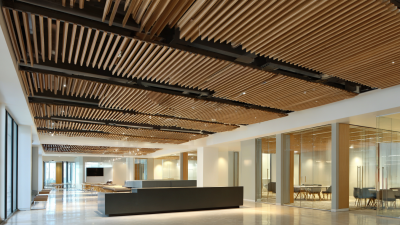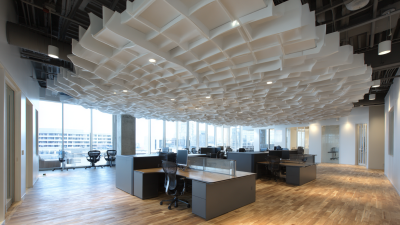Enhancing Your Gym Sound Experience: The Science Behind Acoustic Panels Explained
In the pursuit of an optimal fitness experience, the acoustic environment of a gymnasium plays a pivotal role that is often overlooked. Studies show that sound can significantly affect workouts, with noise levels above 85 decibels leading to decreased concentration and increased stress—key barriers to performance and motivation.

This is where Gymnasium Acoustic Panels come into play, providing a scientifically backed solution to mitigate sound disruption. According to a report by the National Institute for Occupational Safety and Health, excess noise not only hampers physical performance but can also adversely affect long-term well-being.
By strategically installing these acoustic panels, gym owners can enhance the auditory landscape of their facilities, creating a more engaging and productive atmosphere for clients. As the fitness industry continues to evolve, understanding the science behind sound management is essential for delivering an unparalleled workout experience.
Understanding the Importance of Sound Quality in Gyms
In modern gym environments, sound quality plays a pivotal role in enhancing the overall workout experience. Studies have shown that poor acoustic conditions can negatively impact focus and motivation, with research indicating that excessive background noise can lead to reduced performance and increased stress levels. According to the World Health Organization, high sound levels in fitness centers can contribute to auditory fatigue, making it harder for gym-goers to concentrate on their routines.

The integration of acoustic panels is increasingly recognized as a vital component in optimizing sound quality within gyms. These panels are designed to absorb excess noise and reduce echo, creating a more pleasant and encouraging atmosphere. A report published by the Acoustical Society of America revealed that well-treated spaces can improve sound clarity by up to 60%, which can enhance communication between trainers and clients while creating a more inviting environment. Furthermore, a well-designed acoustic space can lead to higher member retention rates, as participants are more likely to return to a gym where they feel comfortable and engaged, as noted in data from the International Health, Racquet & Sportsclub Association (IHRSA).
The Role of Acoustic Panels in Reducing Noise Distraction
When it comes to creating an optimal gym environment, reducing noise distraction is crucial for enhancing focus and motivation. This is where acoustic panels come into play. These sound-absorbing materials effectively diminish echo and reverberation, allowing gym-goers to fully immerse themselves in their workouts without the disturbance of background noise. By strategically placing acoustic panels throughout the gym, you can create a more serene atmosphere that encourages consistent exercise habits.
Tip: When selecting acoustic panels, consider materials that not only absorb sound but also complement your gym’s aesthetic. Fabric-wrapped panels or wood veneer can add a touch of style while improving acoustics.
Additionally, the placement of these panels is essential. Prioritize areas with high noise levels, such as near loud exercise machines or group class spaces. This targeted approach will significantly enhance the overall gym experience, allowing users to focus on their fitness goals.
Tip: For a quick DIY solution, consider adding soft furnishings like rugs and curtains alongside acoustic panels, as they can also help absorb sound and further reduce distractions within the space.

How Acoustic Panel Placement Affects Sound Performance
The placement of acoustic panels plays a crucial role in optimizing sound performance within a gym environment. When strategically positioned, these panels can effectively absorb and diffuse sound waves, reducing echoes and minimizing noise distractions during workouts. Ideally, panels should be installed at first reflection points—areas where sound waves initially bounce off walls—ensuring that they intercept sound before it can disrupt the auditory experience.
Moreover, considering the gym's layout is essential when planning panel placement. High-traffic zones, such as near group exercise classes or weightlifting areas, tend to produce loud sounds. Placing panels in these areas not only improves clarity for instructions and motivation but also enhances the overall ambiance.
Additionally, covering different wall surfaces and incorporating ceiling panels can create a more uniform sound environment, ultimately contributing to a more immersive and enjoyable workout experience. Thus, meticulous planning and thoughtful placement of acoustic panels can substantially elevate sound quality in any gym setting.
Choosing the Right Materials for Effective Acoustic Treatment
When enhancing the sound experience in your gym, selecting the right materials for acoustic treatment is crucial. Different materials possess unique properties that can absorb or reflect sound waves, thereby influencing the overall acoustics of a space. For instance, high-density foam panels are excellent for absorption, particularly in areas where reverberation is a concern. These panels effectively trap sound waves, reducing echoes and creating a more pleasant auditory environment for gym-goers.
In addition to foam, other materials such as fabric-wrapped panels, mineral wool, and diffusers can also be considered. Fabric-wrapped panels not only absorb sound but also provide aesthetic value, allowing gym owners to match their decor while controlling acoustics. Similarly, diffusers scatter sound waves in varied directions, which helps prevent harsh reflections. By combining these materials thoughtfully, you can achieve a balanced sound environment that enhances workouts and promotes overall satisfaction in the gym atmosphere.
Enhancing Your Gym Sound Experience: The Science Behind Acoustic Panels Explained - Choosing the Right Materials for Effective Acoustic Treatment
| Material Type | Sound Absorption Coefficient (0-1) | Thickness (inches) | Cost per Square Foot | Ideal Use Case |
|---|---|---|---|---|
| Mineral Wool | 0.90 | 2 | $1.50 | Gymnasiums and Studios |
| Foam Panels | 0.80 | 1 | $2.00 | Home Gyms and Small Studios |
| Acoustic Panels | 0.95 | 1.5 | $3.00 | Professional Music Studios |
| Carpet Tiles | 0.70 | 0.5 | $1.00 | Multi-Purpose Areas |
| Wood Panels | 0.60 | 0.75 | $4.00 | High-end Gyms and Lounges |
Benefits of a Sound-Optimized Gym Environment for Users
Creating a sound-optimized gym environment is crucial for a better workout experience. The benefits extend beyond mere aesthetics; they include improved concentration, motivation, and overall enjoyment. When acoustic panels are strategically placed, they effectively absorb sound, reducing echo and noise distractions. This leads to an environment where users can focus on their fitness goals without the interference of clanging weights or loud music blending together. Enhanced sound quality not only helps individuals concentrate but also fosters a communal atmosphere where group classes can thrive.
Tips for Enhancing Your Gym's Acoustic Experience:
- Position acoustic panels near high-noise areas, such as weights or cardio machines, to maximize sound absorption.
- Choose materials that complement your gym's design while effectively minimizing sound reflections. Consider options like fabric-wrapped panels or foam.
- Regularly assess the sound levels during peak hours to determine if additional acoustic treatments are needed, ensuring that the environment remains conducive to workouts.
With a thoughtfully designed soundscape, gym-goers can immerse themselves in their routines, leading to more productive sessions and heightened enjoyment.
Related Posts
-

Ultimate Checklist for Choosing the Perfect Stylish Acoustic Panels for Your Space
-

Maximizing Sound Quality with Best Commercial Acoustic Panels Strategies for Effective Use
-

Top Strategies for Utilizing Curved Acoustic Panels in Modern Workspaces
-

How to Enhance Your Space with Interior Acoustic Panels for Better Sound Quality
-

Ultimate Guide to Enhancing Your Space with Black Acoustic Wall Panels
-

Explore Innovations in Interior Acoustic Panels at China Import and Export Fair 2025
-

Phone
-

E-mail
-

wechat
wechat

-

whatsapp
whatsapp


